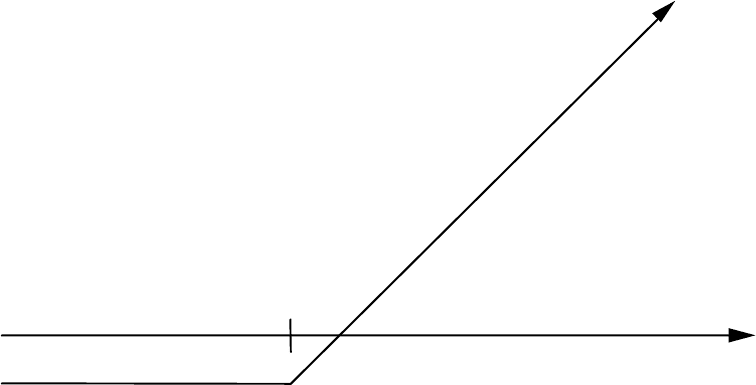Damodaran A. Applied corporate finance
Подождите немного. Документ загружается.


28
It can cut back on production of the less profitable product line and make less profits than
it would have without a capacity constraint. In this case, the opportunity cost is the
present value of the cash flows lost as a consequence.
It can buy or build new capacity, in which case the opportunity cost is the difference in
present value between investing earlier rather than later.
2. Product Cannibalization
Product cannibalization refers to the phenomenon whereby a new product
introduced by a firm competes with and reduces sales of the firm’s existing products. On
one level, it can be argued that this is a negative incremental effect of the new product,
and the lost cash flows or profits from the existing products should be treated as costs in
analyzing whether or not to introduce the product. Doing so introduces the possibility that
of the new product will be rejected, however. If this happens, and a competitor now
exploits the opening to introduce a product that fills the niche that the new product would
have and consequently erodes the sales of the firm’s existing products, the worst of all
scenarios is created – the firm loses sales to a
competitor rather than to itself.
Thus, the decision whether or not to
build in the lost sales created by product
cannibalization will depend on the potential for
a competitor to introduce a close substitute to the new product being considered. Two
extreme possibilities exist: the first is that close substitutes will be offered almost
instantaneously by competitors; the second is that substitutes cannot be offered.
• If the business in which the firm operates is extremely competitive and there are no
barriers to entry, it can be assumed that the product cannibalization will occur
anyway, and the costs associated with it have no place in an incremental cash flow
analysis. For example, in considering whether to introduce a new brand of cereal, a
company like Kellogg’s can reasonably ignore the expected product cannibalization
that will occur because of the competitive nature of the cereal business and the ease
with which Post or General Food could introduce a close substitute. Similarly, it
would not make sense for Compaq to consider the product cannibalization that will
Product Cannibalization: These are sales
generated by one product, which come at the
expense of other products manufactured by the
same firm.

29
occur as a consequence of introducing a Pentium notebook PC since it can be
reasonably assumed that a competitor, say IBM or Dell, would create the lost sales
anyway with their versions of the same product if Compaq does not introduce the
product.
• If a competitor cannot introduce a substitute, because of legal restrictions such as
patents, for example, the cash flows lost as a consequence of product cannibalization
belong in the investment analysis, at least for the period of the patent protection. For
example, Glaxo, which owns the rights to Zantac, the top selling ulcer drug, should
consider the potential lost sales from introducing a new and maybe even better ulcer
drug in deciding whether and when to introduce it to the market.
In most cases, there will be some barriers to entry, ensuring that a competitor will either
introduce an imperfect substitute, leading to much smaller erosion in existing product
sales, or that a competitor will not introduce a substitute for some period of time, leading
to a much later erosion in existing product sales. In this case, an intermediate solution,
whereby some of the product cannibalization costs are considered, may be appropriate.
Note that brand name loyalty is one potential barrier to entry. Firms with stronger brand
name loyalty should therefore factor into their investment analysis more of the cost of
lost sales from existing products as a consequence of a new product introduction.
6.5. ☞: Product Cannibalization at Disney
In coming up with revenues on its proposed theme parks in Thailand, Disney estimates
that 15% of the revenues at these parks will be generated from people who would have
gone to Disneyland in California, if these parks did not exist. When analyzing the project
in Thailand, would you use
a. the total revenues expected at the park?
b. only 85% of the revenues, since 15% of the revenues would have come to Disney
anyway?
c. a compromise estimated that lies between the first two numbers?
Explain.
Project Synergy: This is the increase in cash
flows that accrue to other projects, as a
consequence of the project under consideration.

30
Project Synergy
When a project under consideration creates positive benefits (in the form of cash
flows) for other projects that a firm may have, there are project synergies. For instance,
assume that you are a clothing retailer considering whether to open an upscale clothing
store for children in the same shopping center where you already own a store which
caters to an adult audience. In addition to generating revenues and cash flows on its own,
the children’s store might increase the traffic into the adult store and increase profits at
that store. That additional profit, and its ensuing cash flow, has to be factored into the
analysis of the new store.
Sometimes the project synergies are not with existing projects but with other
projects that are being considered contemporaneously. In such cases, the best way to
analyze the projects is jointly, since examining each separately will lead to a much lower
net present value. Thus, a proposal to open a children’s clothing store and an adult
clothing store in the same shopping center will have to be treated as a joint investment
analysis, and the net present value will have calculated for both stores together. A
positive net present value would suggest opening both stores, whereas a negative net
present value would indicate that neither should be opened.
Illustration 6.9: Cash Flow Synergies with Existing Projects
Assume that the Bookscape is considering adding a cafe to its bookstore. The
cafe, it is hoped, will make the bookstore a more attractive destination for would-be
shopper. The following information relates to the proposed cafe:
• The initial cost of remodeling a portion of the store to make it a cafe, and of buying
equipment is expected to be $150,000. This investment is expected to have a life of 5
years, during which period it will be depreciated using straight line depreciation.
None of the cost is expected to be recoverable at the end of the five years.
• The revenues in the first year are expected to be $ 60,000, growing at 10% a year for
the next four years.
• There will be one employee, and the total cost for this employee in year 1 is expected
to be $30,000 growing at 5% a year for the next 4 years.

31
• The cost of the material (food, drinks ..) needed to run the cafe is expected to be 40%
of revenues in each of the 5 years.
• An inventory amounting to 5% of the revenues has to be maintained; investments in
the inventory are made at the beginning of each year.
• The tax rate for Bookscape as a business is 40%.
Based upon this information, the estimated cash flows on the cafe are shown in Table 6.8.
Table 6.8: Estimating Cash Flows from Opening Bookscape Cafe
0
1
2
3
4
5
Investment
- $ 150,000
Revenues
$60,000
$66,000
$72,600
$79,860
$87,846
Labor
$30,000
$31,500
$33,075
$34,729
$36,465
Materials
$24,000
$26,400
$29,040
$31,944
$35,138
Depreciation
$30,000
$30,000
$30,000
$30,000
$30,000
Operating Income
-$24,000
-$21,900
-$19,515
-$16,813
-$13,758
Taxes
-$9,600
-$8,760
-$7,806
-$6,725
-$5,503
AT Operating Income
-$14,400
-$13,140
-$11,709
-$10,088
-$8,255
+ Depreciation
$30,000
$30,000
$30,000
$30,000
$30,000
- Δ Working Capital
$3,000
$300
$330
$363
$399
-$4,392
Cash Flow to Firm
-$153,000
$15,300
$16,530
$17,928
$19,513
$26,138
PV at 12.14%
-$153,000
$13,644
$13,146
$12,714
$12,341
$14,742
Working Capital
$ 3,000
$ 3,300
$ 3,630
$ 3,993
$ 4,392
Note that the working capital is fully salvaged at the end of year 5, resulting in a cash
inflow of $4,392.
To compute the net present value, we will use Bookscape’s cost of capital of
12.14% (from chapter 4). In doing so, we recognize that this is the cost of capital for a
bookstore, and that this is an investment in a cafe. It is, however, a cafe whose good
fortunes rest with how well the bookstore in doing, and whose risk is therefore, the risk
associated with the bookstore. The present value of the cash inflows is less than the initial
investment of $150,00, resulting in a NPV of -$86,413. This suggests that this is not a
good investment, based on the cash flows it would generate.
Note though, that this analysis is based upon looking at the cafe as a stand-alone
entity, and that one of the benefits of the cafe is that is that it might attract more

32
customers to the store, and get those customers who come to buy more books. For
purposes of our analysis, assume that the cafe will increase revenues at the store by
$500,000 in year 1, growing at 10% a year for the following 4 years. In addition, assume
that the pre-tax operating margin on these sales is 10%. The incremental cash flows from
the “synergy” are shown in Table 6.9.
Table 6.9: Incremental Cash Flows from Synergy
1
2
3
4
5
Increased Revenues
$500,000
$550,000
$605,000
$665,500
$732,050
Operating Margin
10.00%
10.00%
10.00%
10.00%
10.00%
Operating Income
$50,000
$55,000
$60,500
$66,550
$73,205
Operating Income after
Taxes
$29,000
$31,900
$35,090
$38,599
$42,459
PV of Cash Flows @
12.14%
$25,861
$25,369
$24,886
$24,412
$23,947
The present value of the incremental cash flows generated for the bookstore as a
consequence of the cafe is $124,474. Incorporating this into the present value analysis
yields the following:
Net Present Value of Cafe = - $86,413 + $ 124,474 = $38,061
Incorporating the cash flows from the synergy into the analysis, the cafe is a good
investment for Bookscape.
6.6. ☞: Synergy benefits
In the analysis above, the cost of capital for both the cafe and the bookstore were
identical at 12.14%. Assume that the cost of capital for the cafe had been 15%, while the
cost of capital for the bookstore had stayed at 12.14%. Which discount rate would you
use for estimating the present value of synergy benefits?
❒ 15%
❒ 12.14%
❒ An average of the two discount rates
❒ Could be 12.14% or 15% depending upon ....
Explain.

33
In Practice: The Value of Synergy: Disney’s Animated Movies
Disney has a well-deserved reputation for finding synergy in its movie operations,
especially its animated movies. Consider, for instance, some of the spin offs from its
recent movies:
1. Plastic action figures and stuffed toys are produced and sold at the time the movies
are released, producing profits for Disney both from its own stores and from royalties
from sales of the merchandise at other stores.
2. Joint promotions of the movies with fast-food chains such as McDonalds and Burger
King, where the chains give away movie merchandise with their kid’s meals, and
reduce Disney’s own advertising costs for the movie by promoting it.
3. With its acquisition of Capital Cities, Disney now has a broadcasting outlet for
cartoons based upon successful movies (Aladdin, Little Mermaid, 101 Dalmatians),
which produce production and advertising revenues for Disney.
4. Disney has also made a successful Broadway musical of its hit movie “Beauty and the
Beast”, and plans to use the theater that it now owns on Broadway to produce more
such shows.
5. Disney’s theme parks all over the world benefit indirectly since the characters from
the latest animated movies and shows based upon these movies attract more people to
the parks.
6. Disney produces computer software and video games based upon it’s animated movie
characters.
7. Finally, Disney has been extremely successful in promoting the video releases of its
movies as must-have items for video collections.
In fact, on its best-known classics, such as Snow White, Disney released the movie in
theaters dozens of times between the original release in 1937 and the eventual video
release in 1985, making substantial profits each time.
Synergy in Acquisitions
Synergy is often a motive in acquisitions, but it is used as a way of justifying huge
premiums and seldom analyzed objectively. The framework that we developed for
valuing synergy in projects can be applied to valuing synergy in acquisitions. The key to

34
the existence of synergy is that the target firm controls a specialized resource that
becomes more valuable when combined with the bidding firm's resources. The
specialized resource will vary depending upon the merger. Horizontal mergers occur
when two firms in the same line of business merge. In that case, the synergy must come
from some form of economies of scale, which reduce costs, or from increased market
power, which increases profit margins and sales. Vertical integration occurs when a firm
acquires a supplier of inputs into its production process or a distributor or retailer for the
product it produces. The primary source of synergy in this case comes from more
complete control of the chain of production. This benefit has to be weighed against the
loss of efficiency from having a captive supplier, who does not have any incentive to
keep costs low and compete with other suppliers.
When a firm with strengths in one functional area acquires another firm with
strengths in a different functional area (functional integration), synergy may be gained by
exploiting the strengths in these areas. Thus, when a firm with a good distribution
network acquires a firm with a promising product line, value is gained by combining
these two strengths. The argument is that both firms will be better off after the merger.
Most reasonable observers agree that there is a potential for operating synergy, in
one form or the other, in many takeovers. Some disagreement exists, however, over
whether synergy can be valued and, if so, how much that value should be. One school of
thought argues that synergy is too nebulous to be valued and that any systematic attempt
to do so requires so many assumptions that it is pointless. While this philosophy is
debatable, it implies that a firm should not be willing to pay large premiums for synergy
if it cannot attach a value to it.
While it is true that valuing synergy requires assumptions about future cash flows
and growth, the lack of precision in the process does not mean that an unbiased estimate
of value cannot be made. Thus we maintain that synergy can be valued by answering two
fundamental questions:
(1) What form is the synergy expected to take? Will it reduce costs as a percentage of
sales and increase profit margins (e.g., when there are economies of scale)? Will it
increase future growth (e.g., when there is increased market power)?

35
(2) When can the synergy be expected to start affecting cash flows –– instantaneously or
over time?
Once these questions are answered, the value of synergy can be estimated using
an extension of discounted cash flow techniques. First, the firms involved in the merger
are valued independently, by discounting expected cash flows to each firm at the
weighted average cost of capital for that firm. Second, the value of the combined firm,
with no synergy, is obtained by adding the values obtained for each firm in the first step.
Third, the effects of synergy are built into expected growth rates and cash flows, and the
combined firm is re-valued with synergy. The difference between the value of the
combined firm with synergy and the value of the combined firm without synergy
provides a value for synergy.
Options Embedded in Projects
In chapter 5, we examined the process for analyzing a project, and deciding
whether or not to accept the project. In particular, we noted that a project should be
accepted only if the returns on the project exceed the hurdle rate; in the context of cash
flows and discount rates, this translates into projects with positive net present values. The
limitation with traditional investment analysis, which analyzes projects on the basis of
expected cash flows and discount rates, is that it fails to consider fully the myriad options
that are usually associated with many projects.
In this section, we will analyze three options that are embedded in capital
budgeting projects. The first is the option to
delay a project, especially when the firm
has exclusive rights to the project. The
second is the option to expand a project to
cover new products or markets some time in the future. The third is the option to abandon
a project if the cash flows do not measure up to expectations.
The Option to Delay a Project
Projects are typically analyzed based upon their expected cash flows and discount
rates at the time of the analysis; the net present value computed on that basis is a measure
of its value and acceptability at that time. Expected cash flows and discount rates change
Real Option: A real option is an option on a non-
traded asset, such as a investment project or a gold
mine.
36
over time, however, and so does the net present value. Thus, a project that has a negative
net present value now may have a positive net present value in the future. In a
competitive environment, in which individual firms have no special advantages over their
competitors in taking projects, this may not seem significant. In an environment in which
a project can be taken by only one firm (because of legal restrictions or other barriers to
entry to competitors), however, the changes in the project’s value over time give it the
characteristics of a call option.
In the abstract, assume that a project requires an initial investment of X (in real
dollars) and that the present value of expected cash inflows computed right now is PV.
The net present value of this project is the difference between the two:
NPV = PV - X
Now assume that the firm has exclusive rights to this project for the next n years, and that
the present value of the cash inflows may change over that time, because of changes in
either the cash flows or the discount rate. Thus, the project may have a negative net
present value right now, but it may still be a good project if the firm waits. Defining V as
the present value of the cash flows, the firm’s decision rule on this project can be
summarized as follows:
If V > X Project has positive net present value
V < X Project has negative net present value
This relationship can be presented in a payoff diagram of cash flows on this project, as
shown in Figure 6.8, assuming that the firm holds out until the end of the period for
which it has exclusive rights to the project:

37
Present Value of Expected
Cash Flows
PV of Cash Flows
Initial Investment in Project
Figure 6.8: The Option to Delay a Project
Project has negative
NPV in this range
Project's NPV turns
positive in this range
Note that this payoff diagram is that of a call option –– the underlying asset is the project,
the strike price of the option is the investment needed to take the project; and the life of
the option is the period for which the firm has rights to the project. The present value of
the cash flows on this project and the expected variance in this present value represent the
value and variance of the underlying asset.
Obtaining The Inputs For Option Valuation
On the surface, the inputs needed to apply option pricing theory to valuing the
option to delay are the same as those needed for any application: the value of the
underlying asset; the variance in the value; the time to expiration on the option; the strike
price; the riskless rate and the equivalent of the dividend yield. Actually estimating these
inputs for product patent valuation can be difficult, however.
Value Of The Underlying Asset
In the case of product options, the underlying asset is the project itself. The
current value of this asset is the present value of expected cash flows fro initiating the
project now, which can be obtained by doing a standard capital budgeting analysis. There
is likely to be a substantial amount of noise in the cash flow estimates and the present
value, however. Rather than being viewed as a problem, this uncertainty should be
viewed as the reason for why the project delay option has value. If the expected cash
